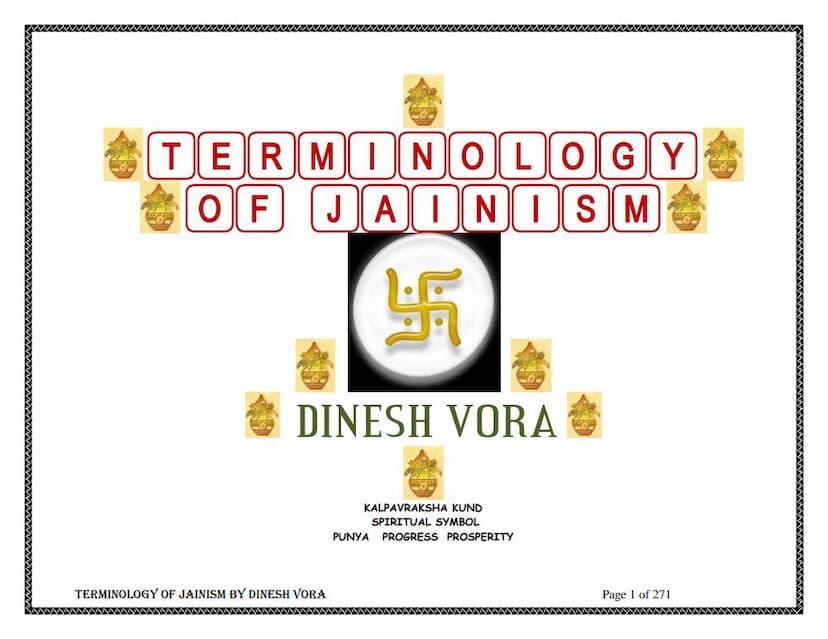Terminology Of Jainism
Added to library: September 2, 2025

Summary
Here's a comprehensive summary of the provided Jain text "Terminology of Jainism" by Dinesh Vora, based on the pages you've shared:
Overview:
"Terminology of Jainism" by Dinesh Vora is a comprehensive glossary designed to explain the foundational concepts, symbols, deities, practices, and philosophical ideas within the Jain tradition. The book aims to simplify the understanding of Jainism by providing clear definitions and context for its technical and spiritual vocabulary. It serves as an educational resource for those seeking to delve into the intricacies of Jain philosophy and practice.
Key Themes and Content:
The book systematically introduces various aspects of Jainism, broadly categorized as follows:
-
Foundational Concepts and Symbols:
- Ahimsa: The central vow of non-violence is prominently displayed on the palm of a wheel, signifying its importance in halting the cycle of reincarnation.
- Swastika: Highlighted as a holy Jain symbol, often created with rice grains around temple altars, with specific mention of the traditional Jain swastika accompanied by three dots and a crest.
- Om: Presented as a significant sound and symbol.
- Kalpavriksha: Recognized as a spiritual symbol of progress and prosperity.
- Divyadhvani: Described as the divine sound or preaching of Tirthankaras.
- Jambudvipa: Identified as a significant geographical concept within Jain cosmology.
-
Deities and Revered Figures:
- Tirthankaras: The book lists all twenty-four Tirthankaras, from Lord Rishabhadeva (Adiinatha) to Lord Mahaveeraswami (Vardhamaana), along with their associated symbols (chinna).
- Important Acharyas and Swamis: Figures like Acharya Kundakunda and Lord Tirthankara Shree Kanji Swami are depicted.
-
Cosmology and Structure of the Universe:
- Siddha Shila: Depicted as the abode of liberated beings (Siddhas).
- Cosmic Structure: The universe is described as eternal (shaswat), self-managed, and never created nor ceasing to exist, comprising various levels like the abode of demigods (Deva), humans and animals (Nara), and space (Aakaasha).
-
Jain Practices and Rituals:
- Manglacharana (Auspicious Initiation): The book details the procedure, starting with Jain greetings ("Jai Jinendra"), followed by the Namokara Mahamantra (obeisance to Arihantas, Siddhäs, Ächäryas, Upädhyäyäs, and Sädhus), and then the Chattari Mangalam (Fourfold Auspiciousness) and Bhaava Namaskara (bowing with adored feelings). The importance of starting any endeavor with these auspicious recitations is emphasized.
- Pronunciation Guide: A helpful section explains the pronunciation of Jain words, including vowel sounds and the significance of 's' at the end of words.
-
Alphabetic Glossary (A-Z):
- The majority of the provided text consists of an extensive alphabetical listing of Jain terminology. Each entry provides the Jain word (often with its Gujarati script) and its corresponding meaning.
- The glossary covers a vast range of concepts, including:
- Knowledge (Gnaana): Mati, Sruta, Avadhi, Manahparyaya, Kevala.
- Karma: Explanations of different types of karma (Ghaati and Aghati, karmic bondage, fruition, etc.).
- Soul (Jiva): Its nature, attributes, and states.
- Non-soul (Ajiva): Dharma, Adharma, Akasha, Kala, Pudgala.
- Vows (Vrata): Mahavratas (major vows) and Anuvratas (minor vows).
- Stages of Spiritual Progress (Gunasthana): Mentioned in relation to conduct and spiritual development.
- Dharma: Explained in multiple contexts, including as righteousness, religion, and the principle of motion.
- Ethical Principles: Ahimsa, Satya, Achaurya, Brahmacharya, Aparigraha.
- Meditation (Dhyana): Arta, Raudra, Dharma, and Shukla Dhyana.
- Cosmological terms: Lokas (worlds), kshetra (regions), time cycles.
- Practices: Austerities (tapa), fasting, renunciation (tyaga), worship (puja).
- Abstract philosophical concepts: Anekaantavada, Syadvada, Naya.
-
Excerpts from Jain Tenets:
- The concluding pages offer a selection of insightful quotes and principles from Jainism, reinforcing core values such as forgiveness, the importance of human birth and punya, the nature of God (as a silent observer, not a creator), the path to salvation through the Three Jewels (Samyag Darshana, Gnana, Charitra), the significance of Ahimsa and Truth, the ten cardinal virtues (Uttama Kshama, Mardava, etc.), and the practice of conquering the self.
Purpose and Audience:
The book is intended for individuals seeking a foundational understanding of Jain terminology, making it accessible to students of Jainism, practitioners, and anyone interested in learning about this ancient Indian religion. The clear, alphabetized structure with detailed definitions makes it a valuable reference tool.
Overall Impression:
"Terminology of Jainism" by Dinesh Vora appears to be a meticulous and comprehensive effort to demystify the complex language of Jainism. Its inclusion of symbols, cosmological concepts, historical figures, and ethical principles, presented in an organized glossary format, positions it as a key resource for Jain education and study.